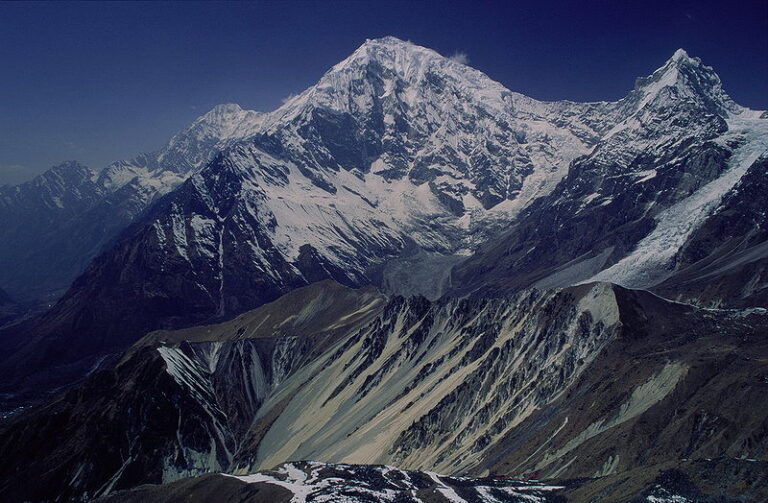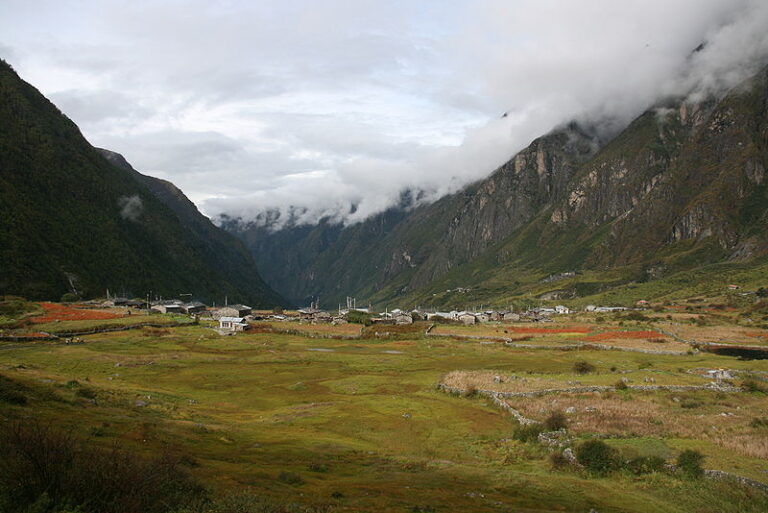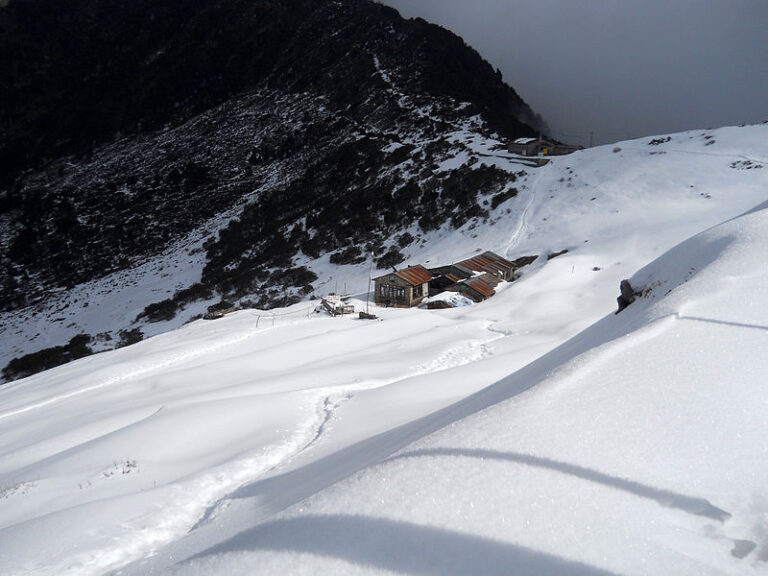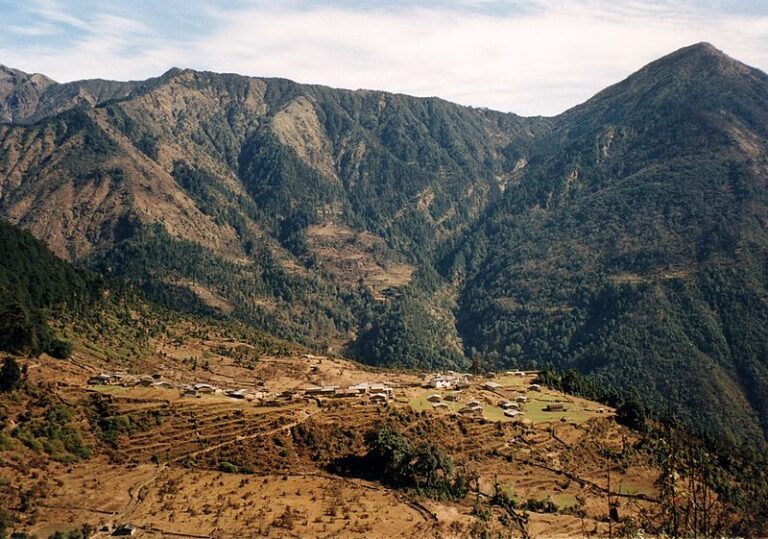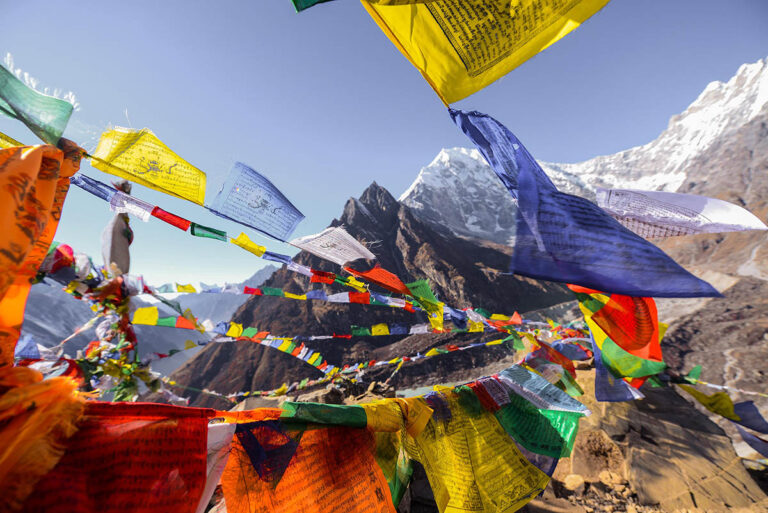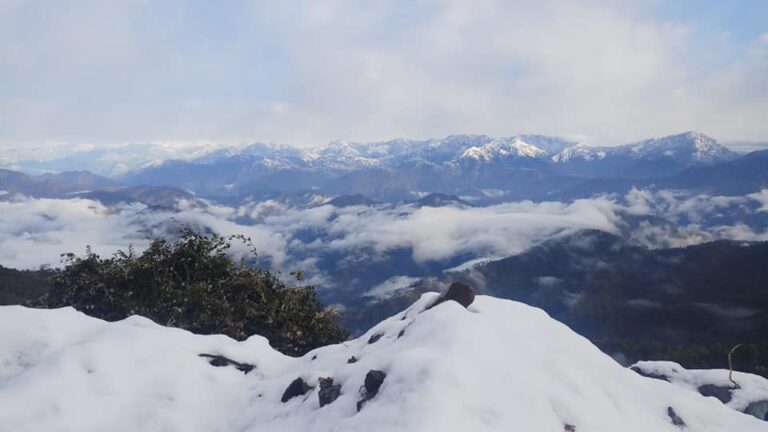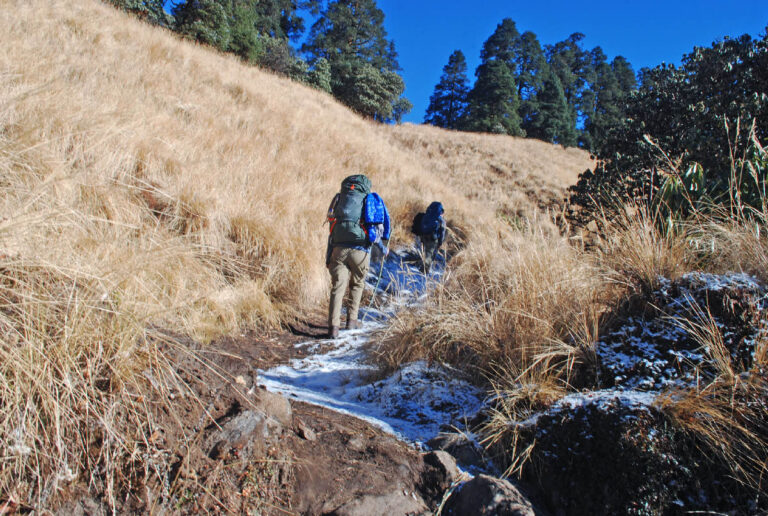Day 01 – Drive to Syabrubesi (1500m.a.s.l) -7 hours drive – Shyabrubesi is 120 kilometers far from Kathmandu city and it is one of the entrance gate for the Langtang national park so we have to drive either public bus or private jeep to get Shyabrubesi. The road is an adventure in itself due to gravel road but still during the driving period we will see beautiful view of Langtang Lirung, Ganesh Himal, agricultural terraced field and many villages, which are settled over the vertical land.
Day 02 – Trek to Sherpa Gaun (2563m.a.s.l) – 5 hours walk – Most of the trekkers follow the main trekking trail following by the Langtang river but to trek via Khanjing Village would be pleasant walk which command us to see beautiful view of snow-caved peaks, verity of landscapes, the gorge of Langtang river, green hill with waterfalls and life style of Sherpa people. Begin of the trek we will ascend about 3 hours to get Bhanjyangdanda viewpoint and the rest of the trail is flat and gradual up until Sherpa Gaun.
Day 03 – Trek to Ghodatabela (3030m.a.s.l) – 6 hours walk – Early in the morning we will walk about 2 hours to get Rimche and Lama Hotel village with the view of green landscape and rocky hills. The trail from Lama Hotel to Ghodatabela is mostly climb up through the forest of pine; oaks, bamboo and Rhododendrons so can be seen some wild life like deer, monkeys, mussels and Himalayan Thar. The Ghodatabela is not a settlement, there is only two basic guesthouses are providing bedrooms and meals to the trekkers.
Day 04 – Trek to Langtang Village (3430m.a.s.l) – 3 hours walk – Langtang Village is not so far from Ghodatabela, it may takes about three hours to get there. But still considering by high elevation trek from Ghodatabela to Langtang Village would be enough for the day. Trek from here to Langtang Village is very pleasant walk due to view of Langtang Lirung, Nayakang and its beautiful ranges. There are dozen of guesthouses are running in Langtang Village which are built after the earthquake.
Day 05 – Trek to Kyanjing Gompa (3830m.a.s.l) – 3 hours walk – While we are heading to Kyanjing Gompa Village, we will pass some of the beautiful villages called Mundu and Sindhum which are settled just bottom of the Langtang Lirung. Along the trekking trail there are dozens of Mani-walls which are built just center of the trekking path. Kyanjing Gompa offer us to see awesome view of Langtang Lirung, Yala Peak, and Ganchenpo.
Day 06 – Sight trip to Tsherko Ri view point (4984m.a.s.l) – 6 hours round trip – There are many sight trips around the Kyanjing Gompa Village known as Kyanjing Ri view point, Langsisha Kharka, Langtang Lirung base camp but still sight trip to Tsherko Ri view point is one of the popular view point around here that command us to see panoramic mountain view of Langtang Lirung, Dorje Lakpa, Ganchenpo, Langsisha, Kinsung, Yala Peak, Nayakang and its beautiful ranges
Day 07 – Trek to Ganjala phedi high camp (4960m.a.s.l) – 5 hours walk – The morning offers us to see glittering view of Langtang Lirung, Ganchenpo, Langtang yubra, Tshero peak and their panoramic view from the breakfast table. After breakfast in Kyanjing Gompa we will head towards Kangla phedi doing by gentle downhill to the Langtang River. From the Langtang River, the trail gently ascends to the Ganjala phedi high camp through the forest of silver birch, Rhododendron and bushy plants. After 4 to 5 hours walk from Kyanjing Gompa we will reach our destination and we will set our tent, having magnificent view of high Himalaya.
Day 08 – Trek over the Ganjala pass (5130m.a.s.l) and trek down to Keldang (4420m.a.s.l) – Today; we will start our trek earlier than previous day due to cross over the Ganjala pass and long walk. The trail from Ganjala phedi to Keldang is really steep and adventurous so requires mental and physical care. From the top of the Ganjala we will have breathtaking Himalayan view to the northward and charm landscapes to the southwards. After snapping some photographs; we will trek down an approximately 4 hours on a downhill trail to get Keldang where we will set out our tent to spend a joyful night.
Day 09 – Trek to Dhukpa (4440m.a.s.l) – 6 hours walk – After breakfast; we will walk down to Dhukpa pass by gigantic pastureland so the area purpose to see some wildlife such as Deer, Blue ship and red Panda. Trek of the day would be one of the pleasant due to see sparkling mountain views and forest around us. After 5 to 6 hours walk we will reach in Dhukpa where we will spend our last tented camp of the trek.
Day 10 – Trek to Tarkeghyang (2600m.a.s.l) – 6 hours walk – Begins of the morning; we will descend an approximately 300 meters to the small stream and then the trail gently ascend to get small hilltop which command us to see spectacular mountain views and Melamchi village valley. Trek from Dhukpa to Tarkeghyang may takes about 6 hours but still our trek would be pleasant due to view of nature, Sherpa settlements and exploration of a monastery which is located in Tarkeghyang village and called Gekye Gompa. Today we will gain delicious meals and drinks with warm hospitality of local guesthouse in Tarkeghyang.
Day 11 – Trek to Shermanthang (2590m.a.s.l) – 4 hours walk – Today is one of the easiest days of the whole trekking trip due to walk on the flat trail. We will walk an approximately 4 hours to get Shermanthang pass by Setighyang, Ghangyul village and some beautiful Mani walls. The major attraction of the day would be agricultural terraced field, green forest, small waterfalls and charm landscapes around us. This night also we will have delicious meals and drinks with great hospitality of Hyalmo people.
Day 12 – Trek to Melamchi pul bazaar and drive back to Kathmandu – After having breakfast in Shermanthang village we will walk down to Melamchi pul bazaar pass by dozens of small villages, stepping by the terraced field and interacting with friendly people. We will have our lunch in Melamchi pul bazaar and drive back to Kathmandu.
Day 13 – Final departure – After exploration of Ganjala pass trek you will fly back to your homeland with great experience of Nepal and many tales about mountain, jungle, colorful Nepali people and their culture, tradition and unique costumes that makes you storyteller among your friends and colleagues.
